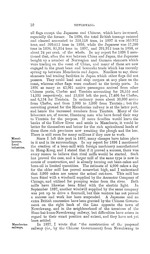| 1 |
 |
“...highly skilled labour as are required for finer goods, such as
shirtings, the freight on the raw cotton to England makes an
appreciable difference in the cost of production. Freights from
New York arc lower than from Liverpool. The goods pass
through fewer hands in America. Prices are also influenced by
the fact that while American manufacturers are using every effort
to secure the market here, Manchester has more orders than can
be immediately executed, and the large demand from India keeps
the mills fully occupied. America does not yet compete with
Great Britain in finer makes." He might have added that the
strikes which one reads of as occurring among operatives in
England, in face of American competition, are not likely to help
the British manufacturer in his attempts to retain the hold which
still remains to him of the markets of the far East. If the value
of the American cottons (490,655/.), and of cotton yarn (446,484/.)
be deducted from the total import of cottons into Fewchwang in...”
|
|
| 2 |
 |
“...and
42,607/., against 166,995 and 21,331 cwts., valued at 386,343/.
and 45,523/. in 1897. It will be noticed that while the volume
of Indian yarn was less in 1S98 than in 1897, the value was con-
siderably greater. The difference in currency was nearly 304,000
Haikwan taels. While, however, the total decrease in the volume
of foreign yarn was 7,501 cwts., the deficiency was almost made
good by an increase of 7,045 cwls. of yarn manufactured by
Chinese steam cotton mills, an important factor which tlie Indian
and Japanese mills will have to lace in the future. The statistical
secretary of the Imperial Maritime Customs dismisses the woollen
trade of China in 1898 with the words:—" The trade in woollen
goods shows no development." Not only was there no develop-
ment, there was an actual decline in currency of over 34 per cent.,
the values of the trade in 1897 and 1898 being 4,838,105 and
3,190,169 Haikwan taels respectively. At this port, with the
single exception of long ells, there was a...”
|
|
| 3 |
 |
“...many changes have taken place
in it and in its surroundings. In my report for 1896 I mentioned
the erection of a bean-mill with foreign machinery manufactured
in Hong-Kong, and I stated that if it proved a success, there was
every reason to believe that rival mills would be started. Such
has proved the case, and a larger mill of the same type is now in
course of construction, and is already turning out bean-cakes and
bean-oil in limited quantities. The estimate of 4,000 cakes a day
for the older mill has proved somewhat high, and I understand
that 3,000 cakes are nearer the actual out-turn. This mill has
been fitted with a windmill supplied by the Aermoter Company of
Chicago, and utilised for pumping water from the river. Botli
mills have likewise been fitted with the electric light. In
September 1897, another windwill supplied by the same company
was put up to drive a flourmill, but this venture has not proved
a success and work has been suspended. A Japanese and an
extra British concession...”
|
|